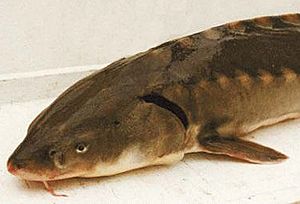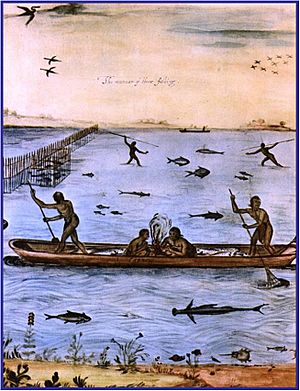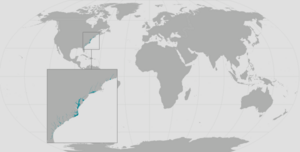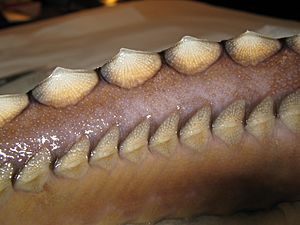Shortnose sturgeon facts for kids
Quick facts for kids Shortnose sturgeon |
|
|---|---|
 |
|
 |
|
| Adult above, juvenile below | |
| Conservation status | |
| Scientific classification | |
| Kingdom: | |
| Phylum: | |
| Class: | |
| Order: |
Acipenseriformes
|
| Family: | |
| Genus: | |
| Species: |
A. brevirostrum
|
| Binomial name | |
| Acipenser brevirostrum Lesueur 1818 non Heckel 1836
|
|
| Synonyms | |
|
|
The shortnose sturgeon (Acipenser brevirostrum) is a small and endangered type of sturgeon found in North America. These fish have been around for a very long time. Their oldest known remains are from over 70 million years ago, during the Late Cretaceous period.
Shortnose sturgeons can live for many years. They also take a long time to become old enough to have babies. Most sturgeons are "bottom-feeders," meaning they eat food found on the riverbed. They are also "anadromous," which means they travel upstream to lay their eggs. However, they spend most of their lives eating in rivers, deltas, and estuaries (where rivers meet the sea).
People sometimes confuse the shortnose sturgeon with young Atlantic sturgeon because they are similar in size. Before 1973, fishing records in the U.S. did not tell the two species apart. Both were simply called "common sturgeon." However, most of the fish caught were likely Atlantic sturgeon. You can tell a shortnose sturgeon apart by its shorter, rounder head.
Contents
Why Shortnose Sturgeons Need Our Help
People have been fishing for shortnose sturgeon for about 4,000 years. Long ago, Native American fishermen caught both shortnose and Atlantic sturgeon for their meat and eggs. When settlers arrived in Jamestown, Virginia in 1607, sturgeon became a main food source for them to survive.
In the 1800s, fishing for shortnose sturgeon became a big business. This led to a fast drop in the number of sturgeon. By the late 1800s, too many sturgeon were being caught. For example, in 1890, over 7 million pounds of sturgeon were harvested in just one year! By 1920, only 23,000 pounds were caught.
Today, the shortnose sturgeon is in danger of disappearing from its natural homes. Because of this, it was listed as an endangered species on March 11, 1967, under the Endangered Species Act. This law helps protect animals that are at risk. The IUCN also listed the shortnose sturgeon as a "vulnerable" species in 2004. This means more plans are needed to help them.
Where Shortnose Sturgeons Live
Historically, shortnose sturgeon lived in coastal rivers along the East Coast of North America. Their range stretched from the Saint John River in New Brunswick, Canada, all the way down to the Indian River in Florida.
Today, you can find shortnose sturgeon in 41 bays and rivers along the East Coast. However, their homes are spread out. There is a large gap of about 250 miles between the northern and southern groups of sturgeon. The number of sturgeon has also decreased in river systems, especially further south.
Modern places where sturgeon lay their eggs include the Saint John River, Bay of Fundy, and the Altamaha River. Sadly, they are no longer seen in North Carolina rivers where they once lived.
The southern groups of shortnose sturgeon are found in rivers like the Great Pee Dee, Waccamaw, Edisto, Cooper, Santee, Altamaha, Ogeechee, and Savannah. They might also be in the Black, Sampit, Ashley, Roanoke, and Cape Fear rivers. Shortnose sturgeon were once thought to be gone from the Satilla, St. Marys, and St. Johns rivers. But recently, they have been found again in the Satilla and St. Marys rivers!
In the northern and mid-Atlantic areas, shortnose sturgeon live in the Saint John (Canada), Penobscot, Kennebec, Androscoggin, Piscataqua, Merrimack, Connecticut, Hudson, Delaware, and Potomac rivers. They have also been seen eating and traveling in other rivers like the St. George, Medomak, Damariscotta, Sheepscot, Saco, Deerfield, East, and Susquehanna rivers. Sometimes, they are even spotted in the Narraguagus, Presumpscot, Westfield, Housatonic, Schuylkill, Rappahannock, and James rivers.
Shortnose Sturgeon Habitat
Shortnose sturgeon live in rivers and coastal waters from Canada to Florida. They are "amphidromous" fish. This means that after they lay their eggs, they spend most of their time in estuaries (where fresh and saltwater mix) and rivers.
Shortnose sturgeon rarely spend time in the Atlantic Ocean. If they do go into ocean waters to eat or travel, they stay close to the shore. These sturgeon are more likely to move through all parts of a river system. They stay in certain spots for longer periods when they are resting or feeding.
Scientists have not yet officially named "critical habitat" for the shortnose sturgeon. Critical habitat is a special area that is very important for a species to survive. More research is needed to find out which habitats are most important for each stage of the sturgeon's life. This will help protect them.
One important area of research is studying what shortnose sturgeon eat and how they grow at different life stages. Scientists also need to understand the benthic habitats (the bottom of the water) that provide their favorite food. Mapping these tiny creatures will help define what sturgeon eat. This information can help scientists figure out where shortnose sturgeon are most likely to be found. It is also very important to learn about and describe the "nursery areas" where young sturgeon grow up.
Description of the Shortnose Sturgeon
The shortnose sturgeon is the smallest of the three sturgeon species found on the eastern coast of North America. It has a body shaped like a cylinder. Compared to the Atlantic sturgeon, its head and snout are quite small. Younger shortnose sturgeons tend to have longer snouts than older ones. Adult sturgeons do not have teeth. Instead, they have bony plates along their esophagus (food pipe) that help them crush hard food items.
Shortnose sturgeon have mostly cartilage instead of bones. Only their skull, jaw, and shoulder area have bones. They are a "physostome" fish. This means their swim bladder (a gas-filled sac that helps them float) is connected to their gut by a special tube. This tube allows them to control the gas pressure by swallowing air or releasing it through their gut. Their intestines are dark and have a spiral valve, which helps them absorb nutrients, much like sharks and rays. As you can see in pictures, these sturgeons are usually dark brown to olive green or black on their backs.
Studies of their stomach contents show that shortnose sturgeon usually eat small bivalves (like clams), gastropods (like snails), polychaetes (a type of worm), and small fish that live on the bottom. The most common food they eat are amphipods (tiny shrimp-like creatures). Atlantic sturgeon, on the other hand, mainly eat polychaetes. Some studies have found that adult female shortnose sturgeon eat all year. However, a study from the Saint John River found that females preparing to lay eggs rarely had food in their stomachs. This suggests they stop eating about eight months before spawning. Males, however, often had full stomachs.
Sturgeon are sometimes called "living fossils." This is because they are a very old type of fish, and their fossil record shows they once lived across the northern parts of the world. The oldest known remains of North American sturgeon date back to the late Cretaceous period. Sturgeons have bony plates called "scutes" that run from their head to their tail. These scutes are arranged in five rows on their body: one row on their back, and two rows on each side and underneath.
The fins on the shortnose sturgeon are located far back on its body. Their pectoral fins (like arms) are positioned low, while their pelvic fins (like legs) are on their belly. Important features of the shortnose sturgeon include their scutes, their mouth that can extend out like a tube, and their "chemosensory barbels" (whisker-like feelers that help them find food by smell).
Sturgeon tend to live a long time, grow slowly, and do not lay eggs very often. These traits helped them survive through evolution. However, they are not good traits when facing human impacts like overfishing, losing their homes, and pollution.
Some animals that might eat shortnose sturgeon include alligators, sharks, and other large fish like catfish. Other known predators are sea lampreys, gar, striped bass, common carp, northern pikeminnow, channel catfish, smallmouth bass, yellow perch, walleye, grey seal, fallfish, and sea lions.
Shortnose Sturgeon Life Cycle and Behavior
The life of a shortnose sturgeon begins when adult fish lay their eggs in freshwater. After laying the eggs, the adults return to saltwater. The eggs are left alone to hatch and grow. As the young fish get older, they slowly move into water that is more salty. They stay in fresh or slightly salty water until they are at least one year old. Male sturgeon can live to be about 30 years old, while females can live to be nearly 70 years old.
Shortnose sturgeon lay their eggs in moving freshwater, usually over rocky or gravelly bottoms. The time they lay eggs changes depending on how far north or south they are. It usually depends on the water temperature, which is between 6.5–15 °C. This can be as early as January in South Carolina or as late as May in Canada.
The eggs hatch after about 13 days. The baby sturgeon are tiny, only 7–11 mm long, and have a large yolk sac for food. They can't see or swim very well yet, and they like to hide. After another 9–12 days, they grow into a swimming larval stage, about 15 mm long. By the time they are 20 mm long, they look like tiny adult sturgeon and start to eat on their own. They then drift downstream in the deep parts of the river, staying in freshwater for their first year. Young sturgeon, up to 18 inches long, usually move to slightly salty water and move with the tides.
Adult sturgeon become ready to have babies when they are about 18 to 22 inches long. Males mature when they are 2–3 years old in warmer places, or 10–14 years old in colder places. Females mature between 6 and 17 years of age, also earlier in southern rivers. Adults continue to grow to be between 3 and 4 feet long. A male might breed every year or every other year and usually does not live past 30. Females usually breed every three to five years. When they breed, they can lay between 40,000 and 200,000 eggs and can live up to 67 years old. Females spend several years eating less and growing slower while they are making the eggs needed for spawning.
Scientists have studied the behavior of young shortnose sturgeon from the Connecticut River and the Savannah River. They found that these fish behave differently when they are very young. This suggests that shortnose sturgeon have adapted their behavior to the unique features of their home rivers.
Threats to Shortnose Sturgeons
Even though there are about 12,000 adult shortnose sturgeon living in the Delaware River estuary today, they face serious threats caused by humans.
- Pollution: Chemicals in the water, like those from pollution, can harm fish. These chemicals have been found in shortnose sturgeon and can cause problems with their reproduction and development.
- Habitat Loss: Heavy industry and building along the waterfront can destroy the sturgeon's home. This can make it hard for them to travel to freshwater to lay eggs or can make their habitat unhealthy.
- Dams: Some dams block the sturgeon's path between saltwater and freshwater. This stops their natural egg-laying cycles and prevents them from having babies.
- Boat Strikes: Sturgeon can be hit by ships and boats.
- Poaching: This is illegal fishing.
- Accidental Catch: Sturgeon can get caught by accident in nets meant for other fish. They are very sensitive to being caught.
- Water Intake Systems: Young sturgeon can be harmed by water intake systems that pull water into power plants or other facilities.
- Construction and Dredging: Building projects in rivers and digging up the riverbed (dredging) can harm spawning areas. The ongoing Delaware River deepening project is an example of this.
- Algal Blooms: Sometimes, too much nitrogen from pollution can cause algal blooms. These can lead to many shortnose sturgeon dying.
Overall, a combination of human activities like destroying habitats and overfishing has greatly harmed many species along the Atlantic Coast. The future effects of climate change are not fully understood, but they could make these problems even worse for struggling fish populations.
How We Are Helping Shortnose Sturgeons
People are working hard to help shortnose sturgeon. One effort is removing old dams from their habitats. The most recent recovery plan was put in place in December 1998. Its goal is to help sturgeon populations grow so much that they no longer need protection under the Endangered Species Act. For each group of sturgeon, the goal is to have enough fish to keep their genes diverse and prevent them from disappearing.
NOAA Fisheries works with conservation groups, energy companies, states, tribes, and citizens. They look for barriers, big and small, to help fish move freely in rivers.
Breeding programs are also being used to help the shrinking sturgeon populations. Fish are caught and bred in special facilities. This helps scientists learn what conditions are best for shortnose sturgeon to grow, survive, and reproduce in the wild. Some sturgeon bred in captivity are also used in educational displays. These displays help teach the public about the challenges facing the species.
Efforts are also being made to teach people about the shortnose sturgeon. Scientists are working with students and teachers to learn more about how sturgeon move, behave, and what threatens them. One example is the SCUTES program, which stands for "Students Collaborating to Undertake Tracking Efforts for Sturgeon." This program provides lesson plans, educational kits, and a chance for classrooms to "adopt" a tagged sturgeon.
Images for kids
Froese, Rainer and Pauly, Daniel, eds. (2009). "Acipenser brevirostrum" in FishBase. February 2009 version.
See also
 In Spanish: Acipenser brevirostrum para niños
In Spanish: Acipenser brevirostrum para niños







